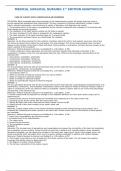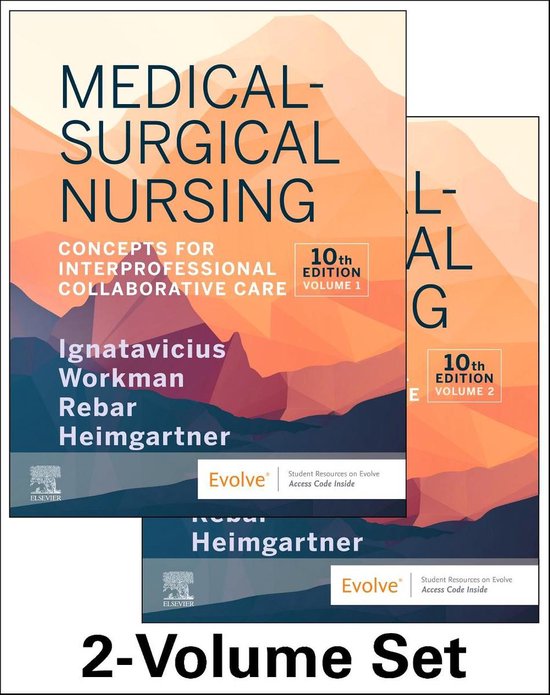MEDICAL SURGICAL NURSING 1ST EDITION IGNATIVICUS
CARE OF CLIENTS WITH CARDIOVASCULAR DISORDERS
SITUATION: Basic knowledge about the physiology of the cardiovascular system will greatly help the nurse to
provide appropriate assessment and interventions. The key component of physical assessment includes a health
history, physical examination, and monitoring of variety of laboratory and diagnostic test results.
1. The pumping action of the heart is accomplished by the rhythmic contraction and relaxation of its muscular wall.
What change occurs during systole?
a. The chambers of the heart become smaller as the blood is ejected
b. The heart chambers fill with blood in preparation for subsequent ejection.
c. The heart chamber of the heart becomes bigger as it receives blood
d. The myocardium becomes thinner as it blood enter the chamber.
ANSWER: A
Rationale: As the blood coming from the systemic circulation enters the inferior and superior vena cava, the atrium
will receive the blood which makes the myocardium thin and enlarged. This occurs during diastole when the heart
relaxes as the chamber of the heart is filled with blood. During systole or contraction, the heart become smaller as the
blood is ejected to the circulation.
Reference: Medical-Surgical by Brunner and Suddarth’s, 11th edition, p.786
2. Cardiac conduction system generates and transmits electrical impulses that stimulate contraction of the
myocardium. Impulses come from two specialized electrical cells. What are the physiologic characteristics of the
electrical cell?
a. Automaticity, excitability, potentiality
c. Conductivity, potentiality, refractivity
b. Automaticity, conductivity, refractivity
d. Automaticity, conductivity, excitability
ANSWER: D
The two specialized electrical cells are the purkinje cells and the nodal cell that is physiologically characterized by its
automaticity, conductivity, and excitability.
Reference: Medical-Surgical by Brunner and Suddarth’s, 11th edition, p.786
3. Automaticity refers to:
a. Ability to transmit an electrical impulse from one cell to another
b. Ability to respond to electrical impulse
c. Ability to initiate an electrical impulse
d. Ability to automatically respond to electrical impulse
ANSWER: C
The two specialized electrical cells are the purkinje cells and the nodal cell that is physiologically characterized by it its
Automaticity, conductivity, and excitability. Automaticity refers to the ability to initiate an electrical impulse. Option A
refers to conductivity of the cell. Option B refers to excitability. Option D doesn’t refer to any of the three physiologic
characteristic of the electrical cell.
Reference: Medical-Surgical by Brunner and Suddarth’s, 11th edition, p.786
4. Cardiac output must be responsive to changes in the metabolic demand. You know that cardiac output can be
determined by:
a. Measuring the amount of blood ejected per heartbeat and multiplying it to the client’s heart rate.
b. Summing up the stroke volume with the client’s heart rate
c. Getting the heart rate of the client and the client’s stroke volume and BP
d. Getting the BP of the client multiply to the client’s heart rate
ANSWER: A
Rationale: Cardiac output refers to the amount of blood pumped by each ventricle during a given period. CO is
computed by multiplying the stroke volume by the heart rate. Stroke volume refers to the amount of blood ejected
per heartbeat.
Reference: Medical-Surgical by Brunner and Suddarth’s, 11th edition, p.786
5. Heart rate is stimulated by the following except:
a. Increased level of the catecholamine
c. The vagus nerve
b. Excess thyroid hormone
d. The sympathetic system
ANSWER: C
Rationale: The increase level of epinephrine and norepinephrine increases the contractility of the heart by stimulating
the sympathetic nervous system. Excess thyroid hormone like in patients with hyperthyroidism, where metabolic
demand is increased, you can observe an increase in the heart rate. Vagus nerve, which is the longest nerve, will
cause bradycardia when stimulated which can be a serious problem especially to patients with cardiac diseases.
Reference: Medical-Surgical by Brunner and Suddarth’s, 11th edition, p.787
6. One student nurse asks you how to determine the stroke volume of the heart. You will answer the question,
knowingly that stroke volume is determined by:
a. The degree of cardiac muscle strength
b. The intrinsic contractility of the cardiac muscle
,c. The pressure gradient against which the muscle ejects blood during contraction
d. All of the above factors
ANSWER: D
,Rationale: Stroke volume is primarily affected by three factors- preload, afterload and contractility. Option A refers to
contractility, option B is refers to preload, option C refers to afterload.
Reference: Medical-Surgical by Brunner and Suddarth’s, 11th edition, p.787
7. You know that there are factors that may bring changes in the cardiac structure associated with aging which
includes all of the following except:
a. Elongation of the aorta
c. Increased sensitivity to baroreceptors
b. Endocardial fibrosis
d. Increased size of left atrium
ANSWER: C
Rationale: The above changes are structural changes that occur as part of the aging process. Instead of increase in
baroreceptors sensitivity, the change that occurs is decrease in its sensitivity. Baroreceptors work under negative
feedback mechanism. When BP is elevated, it transmits impulses to the medulla to lower down the HR and BP and the
opposite.
Reference: Medical-Surgical by Brunner and Suddarth’s, 11th edition, p.786
8. How are you going to assess a client with postural hypotension? Arrange the following in order of execution.
i. Position the client supine and flat
ii. Do not remove the BP cuff between position changes but check to see if the BP is still correctly placed
iii. Supine measurements should be measured before checking the upright position
iv. Assess BP changes with client sitting on the edge of the bed with feet dangling and standing
v. Record HR and BP
a. i, ii, iii, iv, v
b. i, iii, ii, iv, v
c. i, iii, ii, v, iv
d. ii, i, iii, iv, v
ANSWER: B
Rationale: Postural hypotension or orthostatic hypotension occurs when the BP decreases significantly after the
patient assumes an upright posture. It is usually accompanied by dizziness, lightheadedness, or syncope. The proper
order in checking the BP changes should start by positioning the patient first and then measure first the BP in supine
position before an upright position but never remove the BP cuff to avoid any changes related to misplacing or
adjusting the cuff. Lastly document the HR and BP.
Reference: Medical-Surgical by Brunner and Suddarth’s, 11th edition, p.799
9. You assess a patient for postural hypotension and recognize the following are normal postural responses except:
a. An unchanged systolic pressure
c. An increase of 10 mm Hg in the reading
b. A heart rate of 5-20 bpm above the resting rate
d. An increase of 5 mm Hg in diastolic pressure
ANSWER: C
Rationale: Postural hypotension or orthostatic hypotension occurs when the BP decreases significantly after the
patient assumes an upright posture. It is usually accompanied by dizziness, lightheadedness, or syncope. Option C is
incorrect. For us to say that it is normal postural response, it should be a slight decrease of up to 10 mm Hg and not
an increase.
Reference: Medical-Surgical by Brunner and Suddarth’s, 11th edition, p.799.
10. You check the client’s chart and see on the assessment data that the client’s pulse strength is “left radial+2.”
Based on 0-4 rating scale, this means:
a. Diminished pulse and cannot be obliterated
b. Pulse is weak, thready, difficult to palpate and obliterated with pressure
c. Full pulse, easy to palpate, weak and thread
d. Strong and bounding pulse, may be abnormal
ANSWER: A
Rationale: Pulse is weak, thready, and difficult to palpate only if pressure is applied. 0: pulse not palpable or absent.
+1 Pulse is weak, thready, difficult to palpate and obliterated with pressure. +2 diminished pulse and cannot be
obliterated. +3 Full pulse, easy to palpate. +4 Strong and bounding pulse may be abnormal.
Reference: Medical-Surgical by Brunner and Suddarth’s, 11th edition, p.800
11. A nurse is explaining the anatomy and physiology of the heart to a group of adults participating in a wellness
program. When a participant asks for an explanation of the purpose of the superior vena cava, the nurse provides
which of the following information?
a. Returns blood from the body area above the diaphragm
b. Returns blood from the body below the diaphragm
c. Drains blood from the heart
d. Receives freshly oxygenated blood from the lungs through the pulmonary veins
The superior vena cava returns blood from the body area above the diaphragm, the inferior vena cava returns blood
from the body below the diaphragm, and the coronary sinus drains blood from the heart. The left atrium receives
freshly oxygenated blood from the lungs through the pulmonary veins.
SITUATION: Cardiovascular disease is the leading cause of death and showed in later studies that many of the
population, men and women of all racial and ethnic groups are seriously affected by these cardiac conditions.
12. When do coronary arteries primarily receive blood flow?
a. During inspiration
b. During diastole
c. During expiration
d. During systole
ANSWER: B
, Although the coronary arteries may receive a minute portion of blood during systole, most of the blood flow to
coronary arteries is supplied during diastole. This is the relaxation of the muscle, the heart chambers fill with blood in
preparation for the subsequent ejection. Breathing patterns are irrelevant to blood flow.
Reference: Bare, B.G. and Smeltzer, S.C. (2004). Brunner & Suddarth’s Textbook of Medical-Surgical Nursing. 10th
Edition, Vol. 1. Page 647
13. Atherosclerosis impedes coronary blood flow by which of the following mechanisms?
a. Plaques obstruct the vein
c. Blood clots form outside the vessel wall
b. Plaques obstruct the artery
d. Hardened vessels dilate to allow blood to flow through





